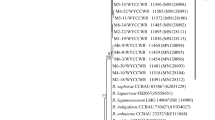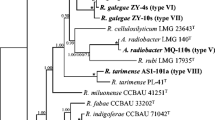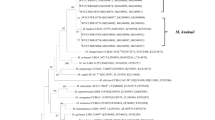Abstract
Aims
To identify the rhizobia nodulating Vicia sativa in Northwestern China and to estimate their geographic distribution.
Methods
Rhizobia trapped with V. sativa plants from soils at six sites in the northwest of China were classified into genotypes by PCR-based restriction fragment length polymorphism (RFLP) of 16S–23S rRNA intergenic spacer (IGS) and 16S rRNA genes, and phylogenetic analyses of housekeeping (16S rRNA, recA, atpD) and symbiotic genes were performed for the representative strains. Soil physicochemical characteristics were recorded and canonical correlation analysis was performed to examine the correlations between soil features and distribution of rhizobial genotypes.
Results
A total of 202 rhizobial isolates were discriminated by RFLP analyses into 15 IGS types and a single 16S rRNA type, which were identified as Rhizobium by 16S rRNA gene phylogeny and as four clusters by multilocus sequence analysis (MLSA). Cluster 1 covering 86 strains and 7 IGS types prevalent in all sites was identified as Rhizobium laguerreae; cluster 2 was R. sophorae with 18 strains in 2 IGS types found in the site Q-GD. Each of cluster 3 and cluster 4 contained three IGS types representing two novel Rhizobium genospecies specific to Gansu Province and Shanxi Province, respectively. Four nodC phylogenetic clades were defined among the isolates.
Conclusions
R. sophorae, R. laguerreae, and two novel Rhizobium genospecies with diverse symbiotic genotypes are associated with Vicia sativa L. in Northwest China. Their biogeographic patterns are mainly directed by soil pH and salinity. This is the first study on the diversity of rhizobia nodulating Vicia sativa in China.



Similar content being viewed by others
References
Akpinar N, Akpinar MA, Turkoglu S (2001) Total lipid content and fatty acid composition of the seeds of some Vicia L. species. Food Chem 74:449–453
Andrews M, De Meyer S, James EK, Stepkowski T, Hodge S, Simon MF, Young JPW (2018) Horizontal transfer of symbiosis genes within and between rhizobial genera: occurrence and importance. Genes 9:24
Braak C, Smilauer P (2002) CANOCO reference manual and CanoDraw for Windows user’s guide: sofware for canonical community ordination (version 4.5). Section on Permutation Methods Microcomputer Power, Ithaca
Cao Y, Wang ET, Zhao L, Chen WM, Wei GH (2014) Diversity and distribution of rhizobia nodulated with Phaseolus vulgaris in two ecoregions of China. Soil Biol Biochem 78:128–137
Chen WX, Li GS, QI YL, Wang ET, Yuan HL, Li JL (1991) Rhizobium huakuii sp. nov. isolated from the root nodules of Astragalus sinicus. Int J Syst Bacteriol 41:275–280
Chen WC, Wang KR, Xie XL (2009) Effects on distributions of carbon and nitrogen in a reddish Paddy soil under long-term different fertilization treatments. Chin J Soil Sci 2009:523–538
Duodu S, Nsiah EK, Bhuvaneswari TV, Svenning MM (2006) Genetic diversity of a natural population of Rhizobium leguminosarum biovar trifolii analysed from field nodules and by a plant infection technique. Soil Biol Biochem 38:1162–1165
Duodu S, Carlsson G, Huss-Danell K, Svenning MM (2007) Large genotypic variation but small variation in N2 fixation among rhizobia nodulating red clover in soils of northern Scandinavia. J Appl Microbiol 102:1625–1635
Ford R, Maddeppungeng AM, Taylor PWJ (2008) Vetch. In: Kole C, Hall TC (eds) Compendium of transgenic crop plants: transgenic legume seeds and forages. Blackwell Publishing, Oxford
Francis CM, Enneking D, Abd El Moneim AM (1999) When and where will vetches have an impact as seed legumes? Proceedings of the 3rd international food legume research conference, Adelaide, Australia
Han L, Wang E, Han T, Liu J, Sui X, Chen W, Chen W (2009) Unique community structure and biogeography of soybean rhizobia in the saline-alkaline soils of Xinjiang, China. Plant Soil 324:291–305
Harrison S, Young JPW, Jones DG (1987) Rhizobium population genetics: effect of clover variety and inoculum dilution on the genetic diversity sampled from natural populations. Plant Soil 103:147–150
Ji Z, Yan H, Cui Q, Wang E, Chen W, Chen W (2015) Genetic divergence and gene flow among Mesorhizobium strains nodulating the shrub legume Caragana. Syst Appl Microbiol 38:176–183. https://doi.org/10.1016/j.syapm.2015.02.007
Jiao YS, Yan H, Ji ZJ, Liu YH, Sui XH, Wang ET, Guo BL, Chen WX, Chen WF (2015) Rhizobium sophorae sp. nov. and Rhizobium sophoriradicis sp. nov., nitrogen-fixing rhizobial symbionts of the medicinal legume Sophora flavescens. Int J Syst Evol Microbiol 65:497–503
Laguerre G, Nour SM, Macheret V, Sanjuan J, Drouin P, Amarger N (2001) Classification of rhizobia based on nodC and nifH gene analysis reveals a close phylogenetic relationship among Phaseolus vulgaris symbionts. Microbiology 147:981–993
Leps J, Smilauer P (2003) Multivariate analysis of ecological data using CANOCO. Cambridge University Press
Lu YL, Chen WF, Wang ET, Guan SH, Yan XR, Chen WX (2009) Genetic diversity and biogeography of rhizobia associated with Caragana species in three ecological regions of China. Syst Appl Microbiol 32:351–361
Mao Z, Fu H, Nan Z, Wan C (2015) Fatty acid, amino acid, and mineral composition of four common vetch seeds on Qinghai-Tibetan plateau. Food Chem 171:13–18
Mikic´ A, Peric´ V, Đorđevic´ V, Srebric´ M, Mihailovic´ V (2009) Anti-nutritional factors in some grain legumes. Biotechnol Anim Hus 25:1181–1188
Nguyen TD, Heenan PB, De Meyer SE, James TK, Chen WM, Morton JD, Andrews M (2017) Genetic diversity and nitrogen fixation of mesorhizobia symbionts of New Zealand endemic Sophora species. N Z J Bot 55:466–478
Odair A, Glaciela K, Mariangela H (2006) Sampling effects on the assessment of genetic diversity of rhizobia associated with soybean and common bean. Soil Biol Biochem 38:1298–1307
Ojha A, Tak N, Rathi S, Chouhan B, Rao SR, Barik SK, Joshi SR, Sprent JS, James EK, Gehlot HS (2017) Molecular characterization of novel Bradyrhizobium strains nodulating ErioSema chinense and Flemingia vestita, important unexplored native legumes of the sub-Himalayan region (Meghalaya) of India. Syst Appl Microbiol 40:334–344
Rahi P, Kapoor R, Young JP, Gulati A (2012) A genetic discontinuity in root-nodulating bacteria of cultivated pea in the Indian trans-Himalayas. Mol Ecol 21:145–159
Rashid MH, Young JP, Everall I, Clercx P, Willems A, Santhosh BM, Wink M (2015) Average nucleotide identity of genome sequences supports the description of Rhizobium lentis sp. nov., Rhizobium bangladeshense sp. nov. and Rhizobium binae sp. nov. from lentil (Lens culinaris) nodules. Int J Syst Evol Microbiol 65:3037–3045
Rathi S, Tak N, Bissa G, Chouhan B, Ojha A, Adhikari D, Barik SK, Satyawada RR, Sprent JI, James EK, Gehlot HS (2018) Selection of Bradyrhizobium or Ensifer symbionts by the native Indian caesalpinioid legume Chamaecrista pumila depends on soil pH and other edaphic and climatic factors. FEMS Microbiol Ecol 94:17
Recourt K, Schripsema J, Kijne JW, van Brussel AA, Lugtenberg BJ (1991) Inoculation of Vicia sativa subsp. nigra roots with Rhizobium leguminosarum biovar viciae results in release of nod gene activating flavanones and chalcones. Plant Mol Biol 16:841–852
Saïdi S, Ramírez Bahena M-H, Santillana N, Zúniga D, Álvarez Martínez E, Peix A, Mhamdi R, Velázquez E (2014) Rhizobium laguerreae sp. nov. nodulates Vicia faba on several continents. Int J Syst Evol Microbiol 64:242–247
Sankhla IS, Tak N, Meghwal RR, Choudhary S, Tak A, Rathi S, Sprent JI, James EK, Gehlot HS (2017) Molecular characterization of nitrogen fixing microsymbionts from root nodules of Vachellia (Acacia) jacquemontii, a native legume from the Thar Desert of India. Plant Soil 410:21–40
Sarita S, Sharma PK, Priefer UB, Prell J (2010) Direct amplification of rhizobial nodC sequences from soil total DNA and comparison to nodC diversity of root nodule isolates. FEMS Microbiol Ecol 54:1–11
Seymour M, Siddique K, Pritchard I, Brandon N, Riethmuller G, Latham L (2003) Common vetch production technology. Food and Agriculture Organization of the United States, Agriculture Western Australia, Horticulture Program 44:1–38
Simonsen AK, Han S, Rekret P, Rentschler CS, Heath KD, Stinchcombe JR (2015) Short-term fertilizer application alters phenotypic traits of symbiotic nitrogen fixing bacteria. PeerJ 3:e1291
Star L, Matan O, Dardanelli MS, Kapulnik Y, Burdman S, Okon Y (2012) The Vicia sativa spp. nigra - Rhizobium leguminosarum bv. viciae symbiotic interaction is improved by Azospirillum brasilense. Plant Soil 356:165–174
Stepkowski T, Banasiewicz J, Granada CE, Andrews M, Passaglia LMP (2018) Phylogeny and phylogeography of rhizobial symbionts nodulating legumes of the Tribe Genisteae. Genes 9:25
Tamura K, Stecher G, Peterson D, Filipski A, Kumar S (2013) MEGA6: molecular evolutionary genetics analysis version 6.0. Mol Biol Evol 30:2725–2729
Tan ZY, Xu XD, Wang ET, Gao JL, Martinez-Romero E, Chen WX (1997) Phylogenetic and genetic relationships of Mesorhizobium tianshanense and related rhizobia. Int J Syst Bacteriol 47:874–879
Tan HW, Heenan PB, De Meyer SE, Willems A, Andrews M (2015) Diverse novel mesorhizobia nodulate New Zealand native Sophora species. Syst Appl Microbiol 38:91–98
Temprano-Vera F, Rodriguez-Navarro DN, Acosta-Jurado S, Perret X, Fossou RK, Navarro-Gomez P, Zhen T, Yu DS, An Q, Buendia-Claveria AM, Moreno J, Lopez-Baena FJ, Ruiz-Sainz JE, Vinardell JM (2018) Sinorhizobium fredii strains HH103 and NGR234 form nitrogen fixing nodules with diverse wild soybeans (Glycine sofa) from Central China but are ineffective on northern China accessions. Front Microbiol 9:17
Terefework Z, Kaijalainen S, Lindstrom K (2001) AFLP fingerprinting as a tool to study the genetic diversity of Rhizobium galegae isolated from Galega orientalis and Galega officinalis. J Biotechnol 91:169–180
Tian C, Wang E, Wu L, Han T, Chen W, Gu C, Gu J, Chen W (2008) Rhizobium fabae sp. nov., a bacterium that nodulates Vicia faba. Int J Syst Evol Microbiol 58:2871–2875
Tian CF, Zhou YJ, Zhang YM, Li QQ, Zhang YZ, Li DF, Wang S, Wang J, Gilbert LB, Li YR, Chen WX (2012) Comparative genomics of rhizobia nodulating soybean suggests extensive recruitment of lineage-specific genes in adaptations. Proc Natl Acad Sci U S A 109:8629–8634
van Brussel A, Recourt K, Pees E, Spaink H, Tak T, Wijffelman C, Kijne J, Lugtenberg B (1990) A biovar specific signal of Rhizobium leguminosarum bv. viciae induces increased nodulation gene-inducing activity in root exudate of Vicia sativa sub-sp. nigra. J Bacteriol 172:5394–5401
Van Cauwenberghe J, Lemaire B, Stefan A, Efrose R, Michiels J, Honnay O (2016) Symbiont abundance is more important than pre-infection partner choice in a Rhizobium-legume mutualism. Syst Appl Microbiol 39:345–349
Vauterin L, Vauterin P (1992) Computer-aided objective comparison of electrophoresis patterns for grouping and identification of microorganisms. Eur Microbiol 1:37–41
Vincent JM (1970) A manual for the practical study of rootnodule bacteria. International Biological Programme (By) Blackwell Scientific, Oxford
Vinuesa P, Silva C, Lorite MJ, Izaguirre-Mayoral ML, Bedmar EJ, Martinez-Romero E (2005a) Molecular systematics of rhizobia based on maximum likelihood and Bayesian phylogenies inferred from rrs, atpD, recA and nifH sequences, and their use in the classification of Sesbania microsymbionts from Venezuelan wetlands. Syst Appl Microbiol 28:702–716
Vinuesa P, Silva C, Werner D, Martínez-Romero E (2005b) Population genetics and phylogenetic inference in bacterial molecular systematics: the roles of migration and recombination in Bradyrhizobium species cohesion and delineation. Mol Phylogenet Evol 34:29–54
Wang ET, Van Berkum P, Sui XH, Beyene D, Chen WX, Martínez-Romero E (1999) Diversity of rhizobia associated with Amorpha fruticosa isolated from Chinese soils and description of Mesorhizobium amorphae sp. nov. Int J Syst Bacteriol 49:51–65
Wang L, Cao Y, Wang ET, Qiao YJ, Jiao S, Liu ZS, Zhao L, Wei GH (2016) Biodiversity and biogeography of rhizobia associated with common bean ( Phaseolus vulgaris L.) in Shaanxi Province. Syst Appl Microbiol 39:211–219
Weir BS, Turner SJ, Silvester WB, Park DC, Young JA (2004) Unexpectedly diverse Mesorhizobium strains and Rhizobium leguminosarum nodulate native legume genera of New Zealand, while introduced legume weeds are nodulated by Bradyrhizobium species. Appl Environ Microbiol 70:5980–5987
Xu KW, Penttinen P, Chen YX, Chen Q, Zhang XP (2013) Symbiotic efficiency and phylogeny of the rhizobia isolated from Leucaena leucocephala in arid-hot river valley area in Panxi, Sichuan, China. Appl Microbiol Biotechnol 97:783–793
Yang SH, Chen WH, Wang ET, Chen WF, Yan J, Han XZ, Tian CF, Sui XH, Singh RP, Jiang GM, Chen WX (2018) Rhizobial biogeography and inoculation application to soybean in four regions across China. J Appl Microbiol 125:853–866
Zhang YM, Li Y, Chen WF, Wang ET, Tian CF, Li QQ, Zhang YZ, Sui XH, Chen WX (2011) Biodiversity and biogeography of rhizobia associated with soybean plants grown in the North China plain. Appl Environ Microbiol 77:6331–6342
Zhang JJ, Liu TY, Chen WF, Wang ET, Sui XH, Zhang XX, Li Y, Li Y, Chen WX (2012a) Mesorhizobium muleiense sp. nov., nodulating with Cicer arietinum L. Int J Syst Evol Microbiol 62:2737–2742
Zhang JJ, Lou K, Jin X, Mao PH, Wang ET, Tian CF, Sui XH, Chen WF, Chen WX (2012b) Distinctive Mesorhizobium populations associated with Cicer arietinum L. in alkaline soils of Xinjiang, China. Plant Soil 353:123–134
Zhang JJ, Yu T, Lou K, Mao PH, Wang ET, Chen WF, Chen WX (2014) Genotypic alteration and competitive nodulation of Mesorhizobium muleiense against exotic chickpea rhizobia in alkaline soils. Syst Appl Microbiol 37:520–524
Zhang YJ, Zheng WT, Everall I, Young JP, Zhang XX, Tian CF, Sui XH, Wang ET, Chen WX (2015a) Rhizobium anhuiense sp. nov., isolated from effective nodules of Vicia faba and Pisum sativum. Int J Syst Evol Microbiol 65:2960–2967
Zhang YJ, Zheng WT, Everall I, Young JP, Zhang XX, Tian CF, Sui XH, Wang ET, Chen WX (2015b) Rhizobium anhuiense sp. nov., isolated from effective nodules of Vicia faba and Pisum sativum grown in southern China. Int J Syst Evol Microbiol 65:2960–2967
Zhang JJ, Jing XY, Philippe dL, Ma C, He PX, Singh RP, Chen WF (2016) Association of white clover (Trifolium repens L.) with rhizobia of sv. trifolii belonging to three genomic species in alkaline soils in North and East China. Plant Soil 407:417–427
Zhang JJ, Yang X, Guo C, de Lajudie P, Singh RP, Wang ET, Chen WF (2017) Mesorhizobium muleiense and Mesorhizobium gsp. nov. are symbionts of Cicer arietinum L. in alkaline soils of Gansu, Northwest China. Plant Soil 410:103–112
Zhang J, Guo C, Chen W, De PL, Zhang Z, Shang Y, Wang ET (2018a) Mesorhizobium wenxiniae sp. nov., isolated from chickpea (Cicer arietinum L.) in China. Int J Syst Evol Microbiol 68:1930–1936
Zhang JJ, Guo C, Chen WF, Shang YM, de Lajudie P, Yang X, Mao PH, Zheng JQ, Wang ET (2018b) Dynamic succession of chickpea rhizobia over years and sampling sites in Xinjiang, China. Plant Soil 425:241–251
Zhang JJ, Shang YM, Wang ET, Chen WF, de Lajudie P, Li BY, Guo C, Yang X, Zheng JQ, Liu CZ (2018c) Mesorhizobium jarvisii sv. astragali as predominant microsymbiont for Astragalus sinicus L. in acidic soils, Xinyang, China. Plant Soil 433:201–212
Zhang BG, Du NN, Li YJ, Shi P, Wei GH (2018d) Distinct biogeographic patterns of rhizobia and non-rhizobial endophytes associated with soybean nodules across China. Sci Total Environ 643:569–578
Zhao L, Deng Z, Yang W, Cao Y, Wang E, Wei G (2010) Diverse rhizobia associated with Sophora alopecuroides grown in different regions of Loess Plateau in China. Syst Appl Microbiol 33:468–477
Zhao L, Fan M, Zhang D, Yang R, Zhang F, Xu L, Wei X, Shen Y, Wei G (2014) Distribution and diversity of rhizobia associated with wild soybean (Glycine soja Sieb. & Zucc.) in Northwest China. Syst Appl Microbiol 37:449–456
Zheng WT, Li Y Jr, Wang R, Sui XH, Zhang XX, Zhang JJ, Wang ET, Chen WX (2013) Mesorhizobium qingshengii sp. nov., isolated from effective nodules of Astragalus sinicus. Int J Syst Evol Microbiol 63:2002–2007
Funding
This work was financed by China Agriculture Research System – Green Manure (Project No. CARS-22), the National Natural Science Foundation of China (Project No. 31400008), and National Human and Social Security Ministry of Science and Technology for Overseas Returnees (Project No. 21104000005). ETW is financially supported by grants SIP20171259 authorized by Instituto Politécnico Nacional, Mexico.
Author information
Authors and Affiliations
Corresponding authors
Additional information
Responsible Editor: Katharina Pawlowski.
Publisher’s note
Springer Nature remains neutral with regard to jurisdictional claims in published maps and institutional affiliations.
Electronic supplementary material
ESM 1
(PPTX 220 kb)
Rights and permissions
About this article
Cite this article
Zhang, J., Shang, Y., Peng, S. et al. Rhizobium sophorae, Rhizobium laguerreae, and two novel Rhizobium genospecies associated with Vicia sativa L. in Northwest China. Plant Soil 442, 113–126 (2019). https://doi.org/10.1007/s11104-019-04168-w
Received:
Accepted:
Published:
Issue Date:
DOI: https://doi.org/10.1007/s11104-019-04168-w




